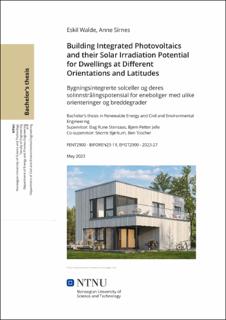| dc.contributor.advisor | Jelle, Bjørn Petter | |
| dc.contributor.advisor | Stensaas, Dag Rune | |
| dc.contributor.advisor | Bjørkum, Snorre | |
| dc.contributor.author | Sirnes, Anne | |
| dc.contributor.author | Walde, Eskil | |
| dc.date.accessioned | 2023-07-08T17:21:59Z | |
| dc.date.available | 2023-07-08T17:21:59Z | |
| dc.date.issued | 2023 | |
| dc.identifier | no.ntnu:inspera:146719958:69459478 | |
| dc.identifier.uri | https://hdl.handle.net/11250/3077372 | |
| dc.description.abstract | Solcellemarkedet er og har vært i stor vekst de siste årene. Nye teknologier og løsninger videreutvikles, og bygningsintegrerte solceller (BIPV) er en av dem. BIPV produserer elektrisitet på samme måte som andre solceller, men skal samtidig kunne fungere som en del av bygningskroppen. Til tross for nye og avanserte løsninger, vil ytterligere forskning være nødvendig før BIPV kan realisere sitt fulle potensial.
Denne studien undersøker mulighetene for å ta i bruk bygningsintegrerte solceller (BIPV) på boliger, ved høye breddegrader. Programvarene Rhinoceros, Grasshopper og deres mange verktøy er brukt for å utføre solinnstrålingsimuleringer, for tre ulike eneboliger. Simuleringene utføres ved ulike orienteringer fra 0° til 360°, i Oslo, Trondheim og Tromsø, som er tre byer med ulike breddegrader i Norge. Resultatene viser at Oslo oppnår de høyeste strålingsverdiene, etterfølgt av Trondheim og deretter Tromsø. Skrått tak oppnådde også de beste strålingsverdiene av alle overflatene til de valgte boligene, etterfulgt av fasadene og deretter de flate takene. Dette var tilfellet i alle tre lokasjoner, men resultatene indikerer at fasadene blir relativt bedre sammenlignet med taket på høyere breddegrader. Det kan til slutt konkluderes med at det er gode muligheter for å ta i bruk BIPV på mindre boliger på høye breddegrader. | |
| dc.description.abstract | The photovoltaic market is and has been growing for the last few years. New technologies and solutions are being further developed and building integrated photovoltaics (BIPV) is one of them. BIPV produces electricity just like any other photovoltaic, but at the same time, it does serve as a part of the building envelope. Despite new and advanced solutions, further research is needed before BIPV can fully realize its potential.
This study investigates the possibilities for utilizing building integrated photovoltaics (BIPV) on dwellings, at higher latitudes. The software programs Rhinoceros, Grasshopper, and their many tools are used to conduct solar irradiation simulations, for three different single-family houses. The simulations are conducted with different rotations ranging from 0° to 360° at the three locations Oslo, Trondheim, and Tromsø, which are all cities at different latitudes in Norway. The results show that Oslo achieves the highest irradiation values, followed by Trondheim and then Tromsø. Pitched roofs did also achieve the best irradiation values out of all the surfaces of the chosen houses, followed by the facades and then the flat roofs. This was the case for all three locations, but the results indicate that the facades become relatively better compared to the roof, at higher latitudes. As a conclusion, there are great possibilities for the utilization of BIPV in both roofs and facades of smaller buildings at higher latitudes. | |
| dc.language | eng | |
| dc.publisher | NTNU | |
| dc.title | Building Integrated Photovoltaics and their Solar Irradiation Potential for Dwellings at Different Orientations and Latitudes | |
| dc.type | Bachelor thesis | |
